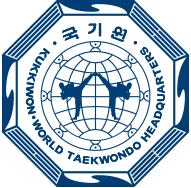Taekwondo practice normally consists of a warm-up, Taekwondo specific training and then a cool-down. As Taekwondo is a modern martial art (since 1955) and is constantly changing in accordance with current scientific research, the warm-up/cool-down can be more scientifically proven than those performed in other more traditional martial arts.
The Taekwondo specific training can be broken down in to a number of areas, not all will be practiced in a single class:
Forms (or poomsae in Korean) are set sequences of movements. This helps the memory and concentration/focus of the student. It's also an area that grows with the student as initially it's a simple "remember the movements in order" exercise but over time the Taekwondoin starts to be given more details specific corrections that they also have to remember. There is normally one new form for each grade or rank (coloured belt or tag/stripe) except for absolute beginners who learn the first form after their first test.
Sparring (or kyorugi in Korean) can be one of two types: step sparring or free sparring. Step sparring (or macho kyorugi) is a sequence of a simple attack (normally a middle or high punch) and a combination of defensive/counter-attacking movements. Free sparring (or shihap kyorugi) is the Olympic form of fighting (although in class it's normally done with light-to-moderate contact rather than full contact unless students are interested in competing in regional, national or international competitions).
Step sparring has many of the same benefits as forms - memory, concentration, focus - but also helps the student learn to deal with the adrenaline and natural reflexes of having someone attack them. Free sparring has less of the form-like benefits but helps develop creative thinking (as students have to consider what defences/attacks to use in a free flowing situation) and quick reactions (as your opponent won't be waiting for you to decide what to do next). Everyone experiences adrenaline dumps in pressure situations (even exams) and Taekwondo sparring can help students learn to deal with them.
Self-defence (or hoshinsool in Korean) is a more free range of attack and defence aimed at teaching students how to extract themselves from physical situations. Initially focussed on releases rather than counter-attacks, these techniques build confidence in the holder.
Destruction or (kyukpa in Korean) is the fairly unique skill of breaking wooden boards, tiles, bricks, etc with the hands and feet. Destruction isn't normally performed by beginners or the youngest of students but with thinner boards normally students can begin after the first few grades are passed. This helps develop confidence and focus. Board breaking is relatively easy once you've practiced the technique consistently, but "holding back" will teach the student a lesson as failing to break a board is a lot more painful than breaking it.



